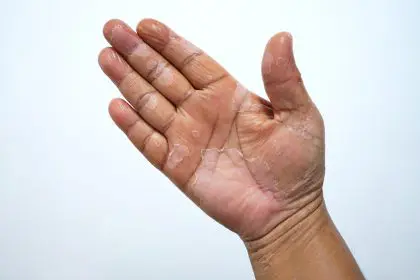Most people associate foot fungus with sweaty gym environments, but medical experts reveal this persistent infection has sneakier ways of spreading. Dr. Michael Thompson at Northwestern Medicine explains how this common condition travels well beyond your feet when left unchecked.
The bathroom connection
Your morning routine might unknowingly spread the infection. Medical professionals note that something as simple as drying off with a towel after showering can transfer fungus to other body parts. Even your luxurious bath mat might harbor unwanted visitors.
The sock drawer surprise
Those cozy socks might tell an uncomfortable truth. Podiatrists explain that wearing the same socks twice – even if they feel clean – can create perfect conditions for fungal spread. The fabric traps moisture and fungal spores, creating an ideal environment for infection.
The hidden hand connection
Scratching that itchy foot then touching other body parts creates a direct pathway for infection spread. Dr. Lisa Martinez at Stanford’s Department of Dermatology explains that people often unknowingly transfer fungus to their hands, face, and other areas through this simple action.
Your shower routine matters
That relaxing evening shower might pose unexpected risks. Medical experts at Mayo Clinic found that certain shower habits, like not drying between your toes or reusing washcloths, significantly increase infection spread. Even your shower floor can become a fungal breeding ground.
The truth about treatment
While many people reach for over-the-counter creams, medical professionals warn that incomplete treatment often leads to spreading. Dr. James Wilson at Mount Sinai Hospital notes that patients frequently stop treatment too soon, allowing the fungus to resurge and spread to new areas.
The clothing connection
Your wardrobe choices influence fungal spread more than you might think. Tight shoes, synthetic socks, and non-breathable fabrics create warm, moist environments where fungus thrives. Medical experts recommend specific fabric choices to prevent spread.
Signs of spreading infection
Medical professionals identify several telling warning signs when foot fungus begins to spread. Watch for redness that moves beyond the original infection site – this often appears first. New itchy patches might develop on hands or other body parts, indicating the fungus has traveled. Unusual skin changes in unexpected places deserve attention, while persistent irritation despite treatment suggests spreading infection.
The moisture factor
Dermatologists emphasize how everyday moisture affects fungal spread. Swimming pools, sweaty workout clothes, and even damp climates can accelerate infection movement across your body. Understanding this connection helps prevent spreading.
Prevention strategies that work
Leading podiatrists share effective prevention techniques which includes – using separate towels for feet and body, implementing proper drying technique, choosing appropriate footwear and maintaining specific cleaning routines
The immune system connection
Recent medical research shows how overall health affects fungal spread. People with compromised immune systems face higher risks of extensive spreading. Understanding this relationship helps patients and doctors develop effective treatment plans.
When to seek professional help
Medical experts outline specific scenarios requiring immediate professional attention – Infection spreading despite home treatment; Multiple body areas showing symptoms; Severe discomfort or inflammation and; Recurring infections despite prevention
The prescription difference
While over-the-counter treatments help many cases, prescription medications sometimes become necessary. Medical professionals explain how to identify when stronger treatment options might be needed.
Environmental factors
Your home environment plays a crucial role in fungal spread. Medical experts recommend specific cleaning practices for bathrooms, bedding, and shoes to prevent reinfection and spread.
The long-term impact
Untreated fungal infections can lead to more serious complications. Dermatologists explain how preventing spread now protects your future health and comfort.
Breaking the cycle
Medical professionals emphasize that breaking the spread cycle requires consistent attention. Understanding how fungus travels helps maintain effective prevention routines.
Future developments
Emerging research offers hope for better treatment options. Medical experts share insights about new approaches to preventing fungal spread and improving treatment effectiveness.
Taking control
Understanding fungal spread empowers better health decisions. Medical professionals emphasize that knowledge combined with consistent prevention creates the best defense against spreading infections.
Remember, while foot fungus might seem like a minor annoyance, its ability to spread makes early intervention crucial. Following medical experts’ advice helps protect your entire body from this persistent condition.












